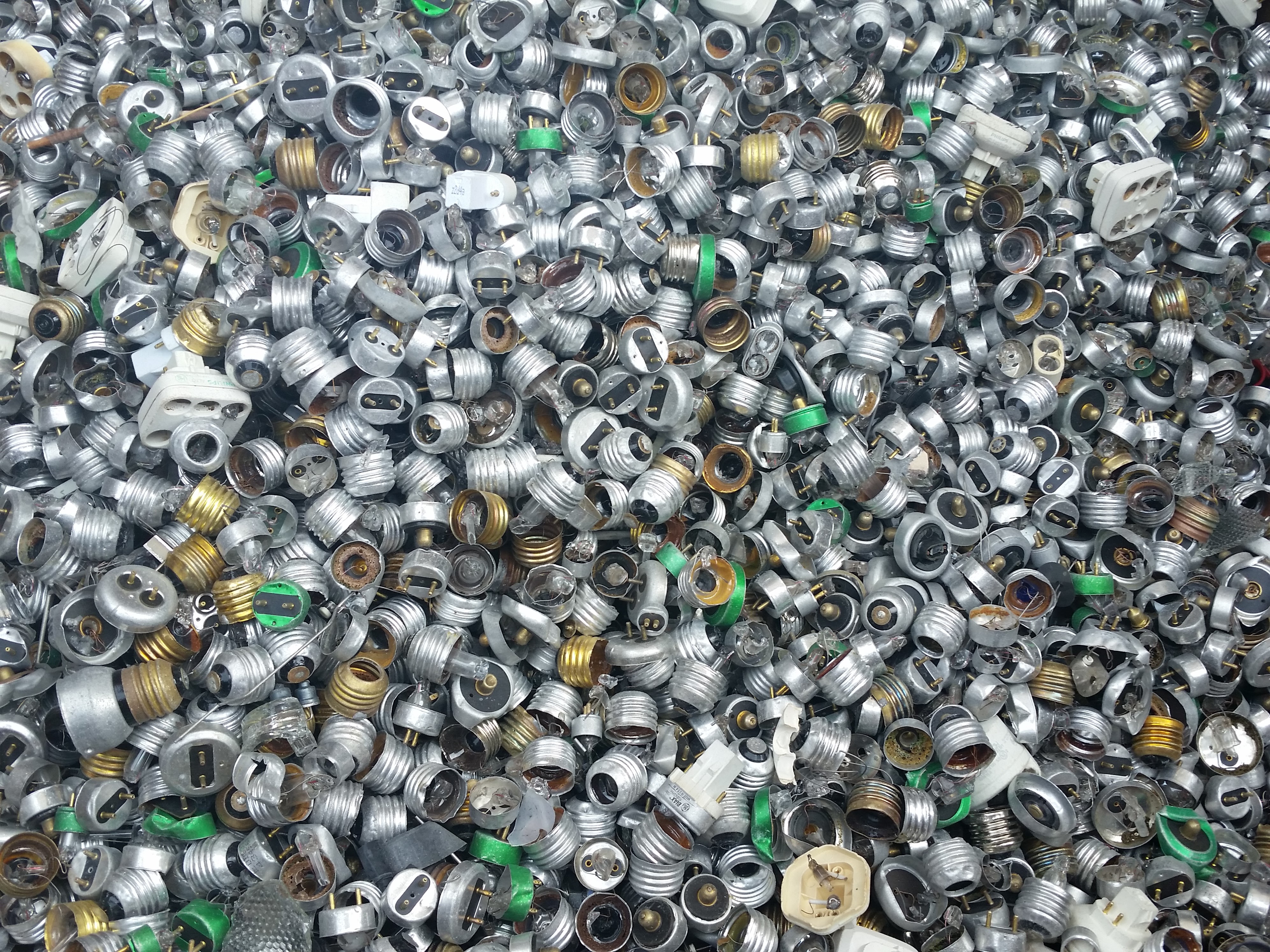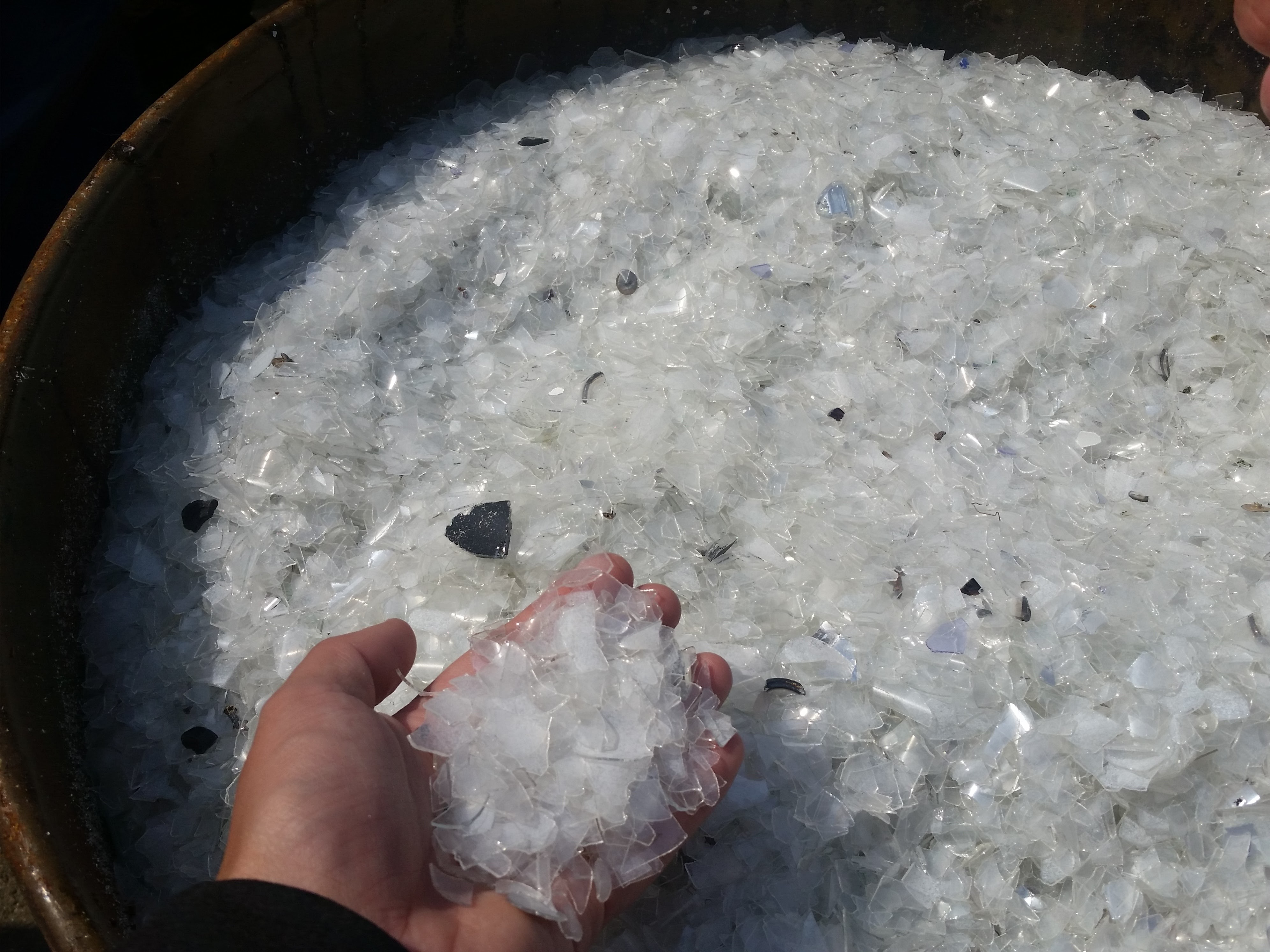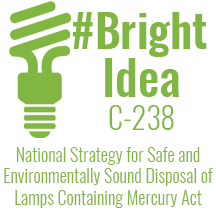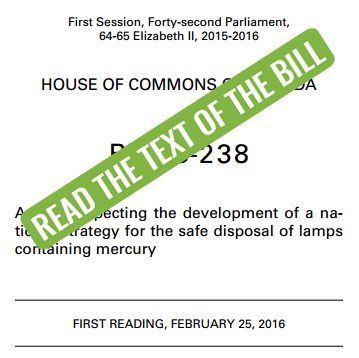
BILL C-238 NOW LAW IN CANADA!
MY PRIVATE MEMBER’S BILL RECEIVED ROYAL ASSENT IN MY FIRST PARLIAMENTARY SESSION AS MP.
Read the release.
Please note that the following is archived text from 2016.
My Bill calls on the Minister of Environment and Climate Change to work with provincial and territorial governments, environmental groups and industry to develop and implement a national strategy to ensure mercury containing lamps are safely disposed of in an environmentally sound way.
During my six years as a municipal councilor I sat on the environment committee. And now I’m pleased to sit on the federal Standing Committee for Environment. Like most Canadians, I want to leave a better world for our children’s future. Strong environmental leadership is imperative to achieving this goal.
We can show environmental leadership by having the Minister work with our provincial and territorial leaders to divert mercury bearing bulbs from our landfills. My riding of Dartmouth-Cole Harbour is home to an innovative facility that recycles mercury bearing light bulbs. Since my nomination I’ve wanted to introduce a Bill concerning the safe disposal of mercury bearing bulbs.
With Bill C-238 I’m not trying to reinvent the light bulb. My hope is that we can show leadership in pursuit of clean technology, protecting our freshwater, lands and improving environmental stewardship for future generations.
We tell consumers to step out of the room if they break a CFL bulb- to worry about mercury vapour in the air. But we don’t protect our land and our waterways from toxic mercury by ensuring the safe disposal of these bulbs in our landfills.
We have an opportunity before us to really affect change for our communities today and in the future with my #BrightIdea.
This is a Canadian government that cares about the environment– and it is time to expect our provinces, cities, towns and municipalities to make bold moves in the right direction. By working together and providing real environmental leadership we can protect our waterways and our lands.
The time is now.

Why care about The National Strategy for Safe and Environmentally Sound Disposal of Lamps Containing Mercury Act?

The metal will be separated and recycled by metal recycling facilities.
Mercury Containing Lamps
Fluorescent lamps contain toxic mercury in varying amounts. Although they are considered to be more energy efficient than incandescent bulbs, care must be taken during disposal.
Compact Fluorescent Bulbs (CFLs) have gained in popularity
For commercial purposes, fluorescent lamps have been popular for some time- however compact fluorescent bulbs (CFLs) have gained popularity among residential consumers. With the Federal ban on 40, 60, 75 and 100 watt incandescent bulbs in 2014- CFL bulbs use is on the rise. A Statistics Canada Report in 2014 showed that “three-quarters of total households reported using one or more compact fluorescent light.”
It must also be noted that Linear Fluorescent Lamps (popular among commercial users) contain large amounts of mercury. According to David Hall, President of DAN-X Recycling, “every four foot fluorescent light bulb has 22 milligrams of mercury. 22 milligrams of mercury can contaminate 220,000 litres of water.”
Q: Why should we care?
A: An integral component of fluorescent lamp and CFL technology is mercury. We know that mercury is toxic and causes health problems like birth defects, rashes or death. This impact on human and environmental health demands preventative measures and solutions. Mercury has the ability to migrate between different media- water, air and soil.
The CCME Council of Ministers in 2001 reported that “waste lamps, whether broken or intact, contribute about 1150 kg/yr. of mercury to landfill each year bound to the phosphor in the glass.”
Mercury contamination has the potential to undergo long-range transport. E.g. Mercury deposited in Eastern Canada has the potential to re-deposit in the Arctic or other remote areas. As Canadians we have a national and global responsibility prevent toxic mercury from entering our landfills.

Once the glass from fluorescent bulbs is processed, it is tumbled to make the edges safe. The glass is then recycled.
How much harm can a regular 13 watt residential light bulb cause?
Equivalent to a 60 watt incandescent, these bulbs contain between 0.17 and 3.6mg of toxic mercury. Some have been known to contact as much as 5mg. This makes the everyday light bulb a large contributor to mercury in our waterways and land.
Safe disposal and recycling facilities for mercury containing lamps exist.
Typical CFLs contain 75% glass, <0.015% mercury, 0.2-2% lead oxide, 0-2% aluminum oxide, 0.5-3% phosphor powder and miscellaneous compounds. Almost all of this can be recycled! DAN-X Recycling Ltd in Dartmouth, Nova Scotia recycles almost every component of mercury containing lightbulbs.
In simple terms, how/what does DAN-X recycle?
- Glass is separated and reused in the production of new bulbs by manufacturers.
- Metal is melted down and reused by metal recycling facilities.
- Phosphorous powder containing mercury is processed and then recycled.
Successful models exist. Some provinces have begun working on CFL end of life strategies while other provinces lag behind. Most notably, British Columbia through the Light Recycle outreach program in 2013 saw 74% of CFL bulbs returned/captured. (Compared to 2010 level of 10% capture rate)
Sources
Canadian Council of Ministers of the Environment Report: Canada-wide Standard for Mercury-containing Lamps (2001) http://www.ccme.ca/files/Resources/air/mercury/merc_lamp_standard_e.pdf
Statistics Canada Uptake and disposal of compact fluorescent lights by Canadian households 2011 http://www.statcan.gc.ca/daily-quotidien/140319/dq140319c-eng.htm
Crowell, M., 2014. CFL Recycling Report: Recommendations for the Collection and Recycling of Spent Residential Compact Fluorescent Bulbs in Nova Scotia. RRFB funded student research report.
Follow the progress of Bill C-238 #BrightIdea
 Use the icons below to share your support for #BrightIdea
Use the icons below to share your support for #BrightIdea
#BrightIdea in the News
Global News, June 26th, 2017
“Canada to develop national strategy on disposing light bulbs containing mercury ”
News 95.7, June 26th, 2017
“Live on the Sheldon MacLeod Show”
Global News Morning Halifax, June 26th, 2017
“MP Darren Fisher gives us an update on Bill C-238.”
CBC News, June 26th, 2017
“National Strategy coming for disposing of mercury-filled light bulbs”
CTV News Atlantic, June 26th, 2017
“N.S. MP introduces bill to change the way Canadians dispose of light bulbs”
Chronicle Herald, June 26th, 2017
“N.S. MP’s bright idea led to national strategy on bulbs”
Waste 260, June 26th, 2017
“New Canadian Law Aims to Help Keep Mercury-Filled Light Bulbs Out of Landfills”
AllNovaScotia (paywall site,) February 2nd, 2017
“Backbencher Darren Fisher Passes Light Bulb Bill”
Chronicle Herald, February 1st, 2017
“MP Fisher’s ‘Bright Idea’ bill passes”
Chronicle Herald, June 25th, 2016
“Leaving the House for home”
CBC News, June 14th, 2016
“Mercury-filled light bulb disposal soon to be federally regulated”
The Hill Times, June 8th, 2016
Liberal MP introduces bill on mercury recycling
AllNovaScotia (paywall site,) June 3rd, 2016
MP Darren Fisher Pushes Bright Idea
Chronicle Herald, September 19th, 2016
“House and Senate back in session: A look at 4 initiatives by Nova Scotian MPs and Senators”
Ottawa Citizen, March 3rd, 2016
“Everything you need to know about the first batch of bills from the backbench”

